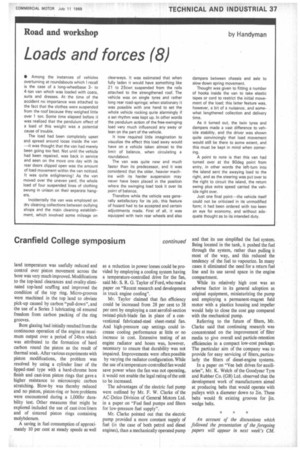Road and workshop by Handyman
Page 39

If you've noticed an error in this article please click here to report it so we can fix it.
Loads and forces (8)
• Among the instances of vehicles overturning at roundabouts which I recall is the case of a long-wheelbase 3to 4-ton van which was loaded with coats, suits and dresses. At the time of the accident no importance was attached to the fact that the clothes were suspended from the roof because they weighed little over 1 ton. Some time elapsed before it was realized that the pendulum effect of a load of this weight was a potential cause of trouble.
The load had been completely upset and spread around loose inside the van —it was thought that the van had merely been going too fast, Not until the vehicle had been repaired, was back in service and seen on the move one day with its rear doors clipped open was the amount of load movement within the van noticed. It was quite enlightening! As the van moved over the uneven yard, the whole load of four suspended lines of clothing swung in unison on their separate hangers.
Incidentally the van was employed on dry cleaning collections between outlying shops and the main cleaning establishment, which involved some mileage on clearways. It was estimated that when fully laden it would have something like 21 to 25cwt suspended from the rails attached to the strengthened roof. The vehicle was on single tyres and rather long rear road-springs; when stationary it was possible with one hand to set the whole vehicle rocking quite alarmingly if a set rhythm was kept up. In other words the pendulum action of the free-swinging load very much influenced any sway or lean on the part of the vehicle.
It now required little imagination to visualize the effect this load sway would have on a vehicle taken almost to the limit of balance, when circulating a roundabout.
The van was quite new and much faster than its predecessor, and it was considered that the older, heavier machine With its harder suspension may never have been placed in the position where the swinging load took it over its point of balance.
Therefore while the vehicle was generally satisfactory for its job, this feature of hazard had to be accepted and certain adjustments made. First of all, it was equipped with twin rear wheels and also dampers between chassis and axle to slow down spring movement.
Thought was given to fitting a number of hooks inside the van to take elastic tapes or cord to restrict the initial movement of the load; this latter feature was, however, a bit of a nuisance, and somewhat lengthened collection and delivery time.
As it turned out, the twin tyres and dampers made a vast difference to vehicle stability, and the driver was shown quite convincingly that load movement would still be there to some extent, and this must be kept in mind when cornering.
A point to note is that this van had turned over at the 90deg point from entry, in other words the left-turn into the island sent the swaying load to the right, and as the steering was put over to the right to circuit the island, the return swing plus extra speed carried the vehicle right over.
Just one final point—the vehicle itself could not be criticized in its unmodified form; it had been ordered with too keen an eye for economy, and without adequate thought as to its intended duty.












































































































